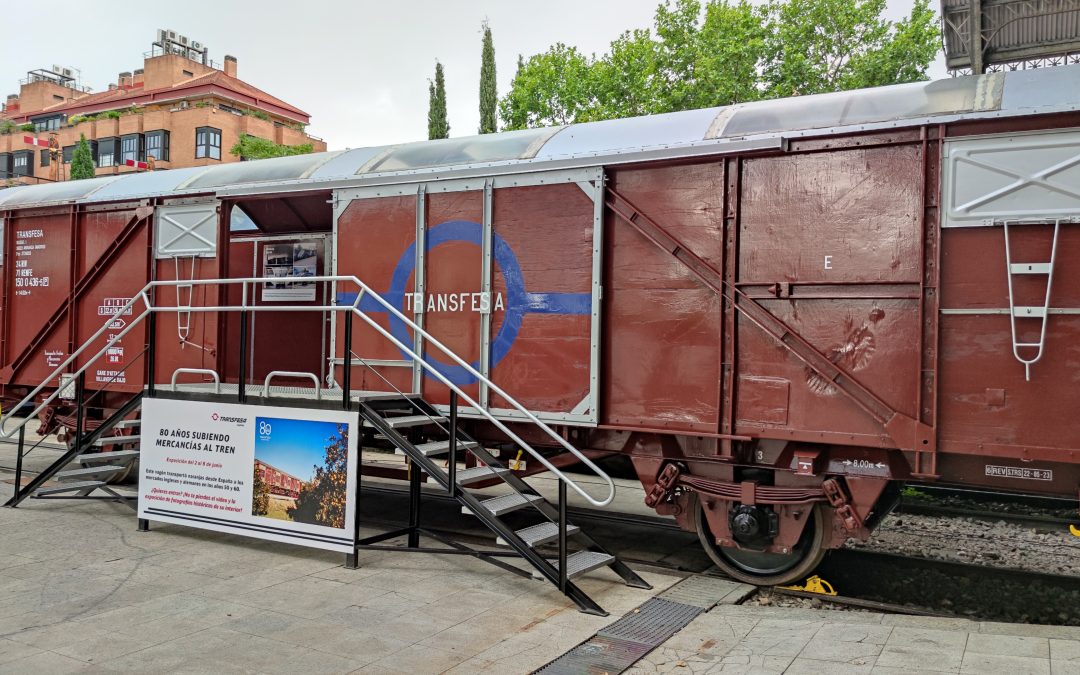- On the occasion of Transfesa Logistics’ 80th anniversary, a historic orange wagon from the company will be at the Madrid Railway Museum, managed by the Spanish Railway Foundation, from the 2nd until the 8th of June, and will be open to visitors inside, where it contains an exhibition on the company’s history.
- This historic Transfesa freight wagon transported citrus fruit from eastern Spain to London in the 1950s and 1960s.
Transfesa Logistics, one of Spain’s leading railway operators, celebrates its 80th anniversary with an exhibition open to the public at the Railway Museum in Madrid, managed by the Spanish Railway Foundation, which will be open to the public from 2 to 8 June.
A historical wagon used by the company to transport citrus fruit in the 50s and 60s from the Levant to the English and German markets will be the setting for an audiovisual exhibition that reviews the history of the company, whose trajectory has been key for the development of the railway and freight transport in Spain.
Transfesa was created in 1943 to solve the difficulties of transporting live cattle in post-war Spain. The first 100 wagons with which the company began to operate were purchased in Germany. Later, in 1952 and with the aim of resolving the difference in track gauge, Transfesa invented a new way of carrying out international transport, designing the first wagons with interchangeable axles and the axle change stations at the Hendaye and Cerbère frontiers. In this way, only the axles of the wagons were changed and the goods did not have to be handled. This was a revolution for the market, opening the doors to Europe and becoming one of the first European railway companies to provide international transport.
During this decade and the following one, Transfesa, after breaking the Spanish railway isolation, focused on transporting citrus fruits from the Levant to the rest of Europe. Until then, the fruit did not arrive in optimal conditions, but thanks to Transfesa’s ventilated wagons, Spanish oranges were on the Covent Garden market in London and in the markets of many German cities within 48 hours. These services were a great success and the train was known as “el naranjero”.
In the 1960s, the company set up offices in France, the United Kingdom, Switzerland, Germany and Portugal. It thus became one of the only Spanish multinationals. Transfesa was a key driving force in boosting international trade in products made in Spain.
In the 1970s, Transfesa continued to reinvent itself and focused on the automotive factories that had been established in our country since the 1950s. It thus became a key partner for the main car manufacturers and began transporting finished vehicles.
Later, in the 1980s, it also began to transport automotive components to service the production chain of factories located throughout Europe.
The railway company continues to identify various additional needs of its customers and therefore starts to develop other logistics businesses beyond rail transport itself in the 1990s, such as maintenance and repair of railway assets, operates warehouses and starts to manage railway terminals. In this way, it accompanies its customers throughout their entire value chain. In the 2000s, an important milestone was reached when the German company DB landed in Spain and acquired a majority stake in Transfesa. This company has always stood out for being a pioneer in the promotion of international transport and for the first time in its history, in 2023 it began to operate standard gauge trains between the Iberian Peninsula and the rest of Europe. Today Transfesa Logistics is also making history through the “Freight belongs on rail” initiative, which for the first time has managed to bring together operators, institutions, shippers, ports and NGOs to jointly promote rail freight transport as the most sustainable means of transport, as it emits 80% less CO2 than its equivalent by road.

